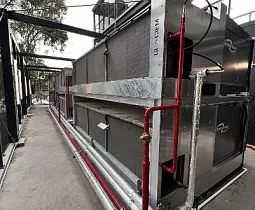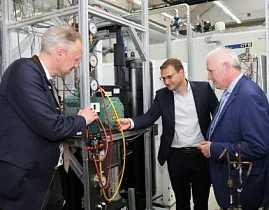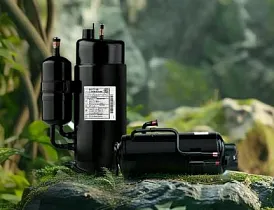
On January 10th, the North American Sustainable Refrigeration Council (NASRC) presented a Natural Refrigerant Seminar and Live CO2 Demo at the Danfoss Headquarters. Sponsored by CoolSys and Danfoss, the seminar shared insights on natural refrigerant applications in supermarkets, and why they are considered a “future-proof” alternative to HFC refrigerants. This seminar was attended by food retail end-users, service contractors, and other commercial refrigeration stakeholders, as well as utilities, government agencies, and nonprofits.
Danielle Wright, the Executive Director of the NASRC, kicked off the seminar with an overview of natural refrigerants, which include ammonia, carbon dioxide (CO2), and hydrocarbons. Wright discussed the significant climate benefits that natural refrigerants offer compared to commonly used hydrofluorocarbon (HFC) refrigerants, citing that HFC refrigerant leaks in U.S. supermarkets result in roughly 152 billion pounds of CO2e emissions annually. Wright also reviewed the wide range of natural refrigerant equipment options available on the market and the benefits and barriers to adopting these technologies.
One significant factor driving food retailers to consider natural refrigerant options is the increasing refrigeration regulations at the state, federal, and global level. Christina Starr of the Environmental Investigation Agency (EIA) provided an overview of current refrigerant regulations and the role they are playing in the adoption of natural refrigerants. Most notably, Starr discussed the increasing commitments to reduce HFCs at the state level. Given the considerable climate benefits that low-GWP refrigerants offer, many states are announcing HFC regulations to help meet their climate goals. California was the first state to make a commitment to phase-down HFCs, with a goal of reducing HFC emissions by 40% by the year 2030. More recently, New York, Connecticut, Maryland, and Washington have announced HFC regulatory commitments.
“It is critical for States to understand the burden HFC regulations place on the supermarket sector,” said Danielle Wright of the NASRC. “Food retailers have a huge potential to help these states accomplish their climate goals, especially if proposed regulations reduce the barriers preventing the adoption of climate-friendly refrigeration alternatives.”
Incentive programs for low-global warming potential (GWP) refrigerants are one solution states are exploring to help offset the incremental costs that have been cited as a barrier to supermarket adoption of natural refrigerant-based technologies. Incentive programs have the power to accelerate the adoption of low-GWP refrigeration technologies, moving them closer to reaching economies of scale. Thus, these programs can decrease the cost barriers that prevent many supermarkets from adopting low-GWP technologies beyond the states administering the programs. In California, Senate Bill 1013 was signed into law in 2018, which included the approval of a state-wide incentive program for low-GWP refrigerants. Other committed states have announced an interest in pushing for incentives as well.
The second half of the seminar focused on CO2 as a refrigerant. Tony Lundell and Eric Smith of the International Institute for Ammonia Refrigeration (IIAR) presented on the status of their CO2 safety standard, expected to be finalized within the next year. This standard is intended to specify the minimum requirements for the safe use of CO2 as a refrigerant in industrial and commercial applications.
Peter Dee of Danfoss followed IIAR, with an overview of the “mega-trends” the commercial industry is experiencing, such as a rise in digitalization, increasing urban populations, and a changing climate. He also shared insights on the technological advances that have improved the performance of CO2 transcritical systems, allowing this technology to be adopted by more supermarkets. With refrigeration accounting for roughly half of a supermarket’s annual electricity use, the energy performance of a system is a significant cost consideration. The improved performance of CO2 transcritical has made it a viable option for more supermarkets in more geographic locations.
Danfoss closed the seminar with a live demonstration of a CO2 transcritical system using their mobile training unit. Attendees left the event with a more in-depth understanding of natural refrigerant options, the latest technology trends, and the barriers and solutions influencing the adoption of these technologies.

